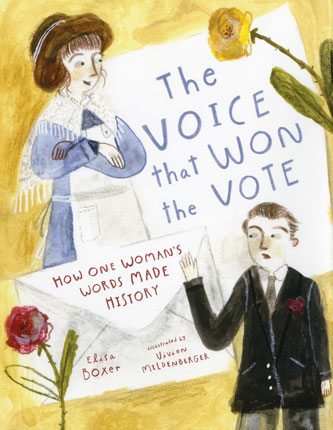| Voice that won the vote : how one woman's words made history Author: Boxer, Elisa | ||
| Price: $6.50 | ||
Summary:
Women's suffrage in America came down to a single voter in Tennessee who voted yes because of a letter his mother had written, urging "Vote for suffrage and don't forget to be a good boy." This is the story of the letter than gave all American women a voice.
| Illustrator: | Mildenberger, Vivien |
| Accelerated Reader Information: Interest Level: LG Reading Level: 4.40 Points: .5 Quiz: 515230 |
Reviews:
Kirkus Reviews (01/01/20)
School Library Journal (03/01/20)
Booklist (03/01/20)
Full Text Reviews:
School Library Journal - 03/01/2020 Gr 1–5—Engaging cartoon illustrations and snappy text make this story about women's suffrage perfect for very young children. The familiar heroines of the movement (Susan B. Anthony, Alice Paul) are included only in a time line, as the book's main characters are Harry Burn, a little-known lawmaker, and Febb Burn, his mother. In August of 1920, American women looked to Tennessee, hoping it would become the necessary 36th state to ratify the 19th amendment. But the first round of voting resulted in a tie. When Representative Burn changed his vote, he changed history. Although Burn knew that breaking the tie would jeopardize his chance at state reelection, he was determined to follow his conscience (and the advice of his mother). VERDICT A most suitable lesson for our time. Author Boxer and illustrator Mildenberger offer a concise look at a lesser-known player who contributed to a significant part of American history.—Gloria Koster, formerly at West School, New Canaan, CT - Copyright 2020 Publishers Weekly, Library Journal and/or School Library Journal used with permission.
Booklist - 03/01/2020 This informational picture book describes how Harry T. Burn, a member of the Tennessee House of Representatives, made history in 1920 by voting yes to break the tie vote and ratify the Nineteenth Amendment, giving women the vote. Burn, initially anti-suffrage—signified by the red rose in his lapel—reversed his no vote after receiving a plea in the form of a letter from his mother, Febb Burn, a college-educated women's rights supporter. Boxer's writing makes this moment in history come alive, and the book's back matter includes a photo of Febb, a time line, and further information. Mildenberger's watercolor illustrations appealingly juxtapose people voting in present day with historical renderings of that momentous time in history, although the blend of Black suffragettes with their white counterparts wasn't as common as the illustrations suggest, due to the prevalent racism of the time. Likewise, the claim that Febb's actions resulted in all women gaining a voice is somewhat oversimplified. Still, this is an inspiring addition to the influx of books celebrating the Nineteenth Amendment's centennial. - Copyright 2020 Booklist.



